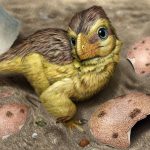Ancient Roman glass cups hold secret messages from their creators
In early 2023, art historian and glassblower Hallie Meredith stood inside a quiet gallery at the Metropolitan Museum of Art when she noticed something...
Scientists recover the world’s oldest RNA from a 40,000-year-old woolly mammoth
For the first time in history, scientists have extracted and decoded RNA molecules from the remains of an Ice Age woolly mammoth.
The breakthrough, achieved...
Dinosaur eggshells provide a new way to tell time in the fossil record
Scientists have discovered a groundbreaking way to measure time in the distant past—by dating fossilized dinosaur eggshells.
This new technique could transform how researchers determine...
Continents slowly “peel away” to create ocean volcanoes, study finds
A team of Earth scientists has discovered that continents are slowly peeling apart from below—sending fragments deep into the oceanic mantle, where they can...
The ground is sinking fast in Arizona’s Willcox Basin — Here’s why
In Arizona’s Willcox Basin, just over an hour east of Tucson, the ground is sinking, wells are drying up, and deep cracks are splitting...
Ancient DNA reveals a 40,000-year story of human–Denisovan interbreeding across Eurasia
New genetic research has shed fresh light on one of the most mysterious chapters in human evolution—the relationship between modern humans and Denisovans, an...
Ancient stone tools from Kenya reveal a turning point in human evolution
In a groundbreaking discovery, scientists have uncovered one of the oldest and longest-lasting collections of stone tools ever found—evidence that early humans had already...
Rare dinosaur discovery in West Texas expands ancient species’ known range
A surprising fossil discovery in the desert of West Texas has revealed that a dinosaur species once thought to roam only the northern parts...
Scientists discover “arctic rhino” fossil in Canada, the northernmost rhino ever found
Scientists have identified a new extinct species of rhinoceros that once roamed Canada’s High Arctic—a remarkable find that sheds new light on how ancient...
Six-million-year-old Antarctic ice reveals secrets of a warmer ancient Earth
Scientists have discovered the oldest directly dated ice on Earth—an incredible six million years old—deep in the frozen expanse of East Antarctica.
The ice, along...










